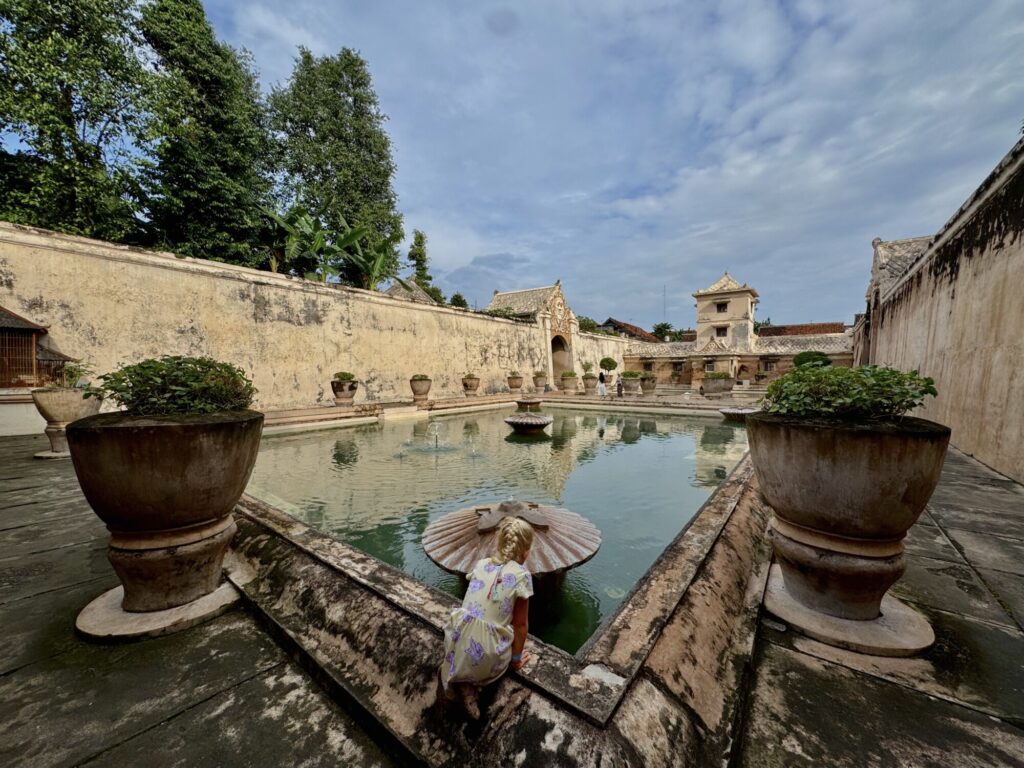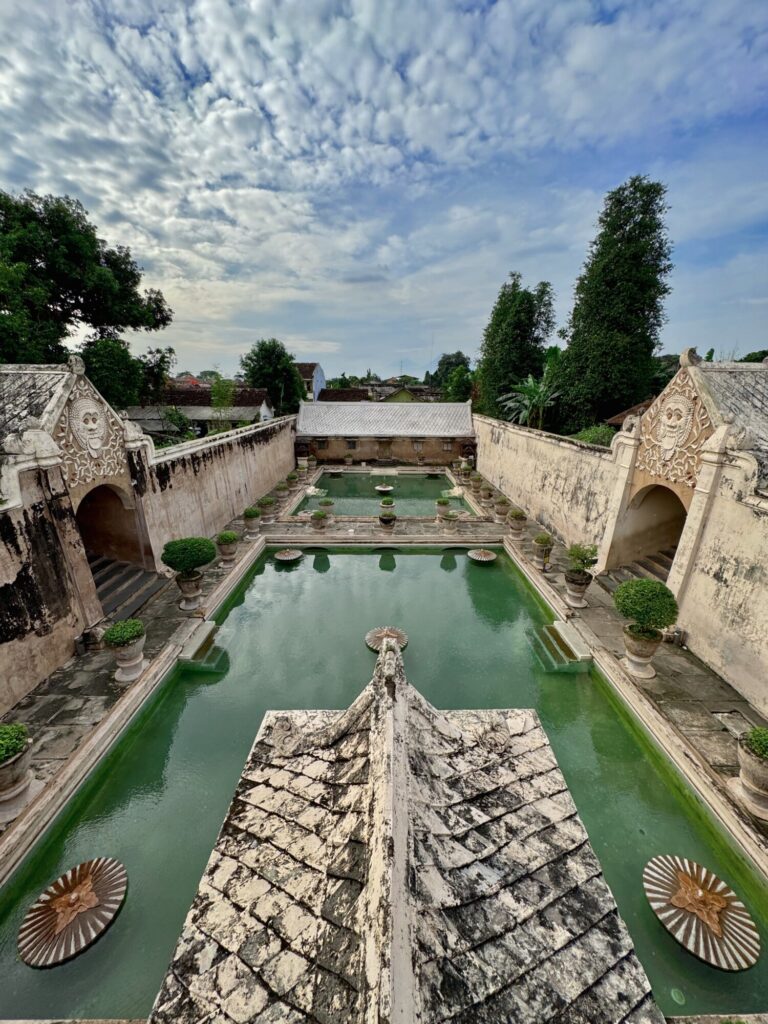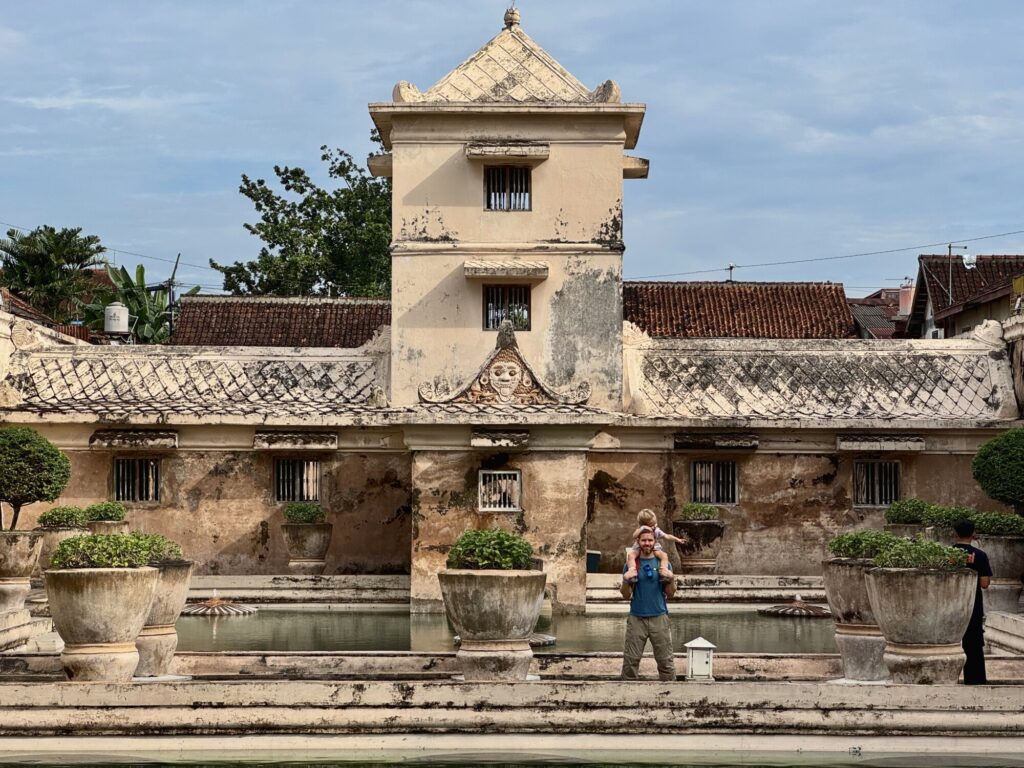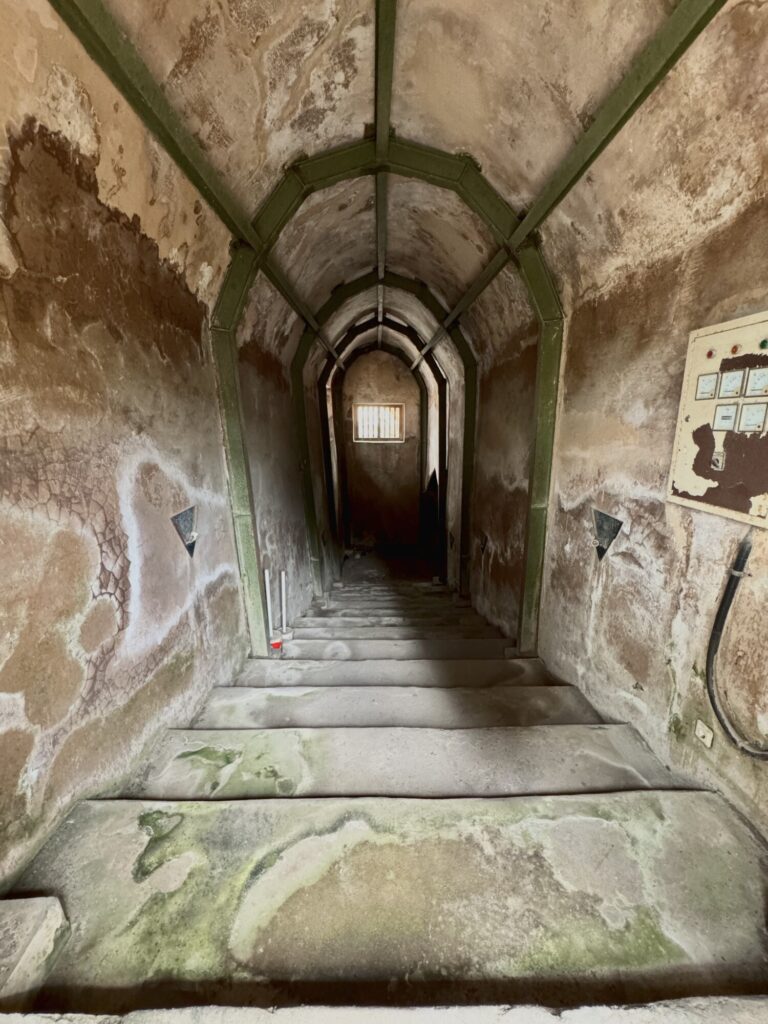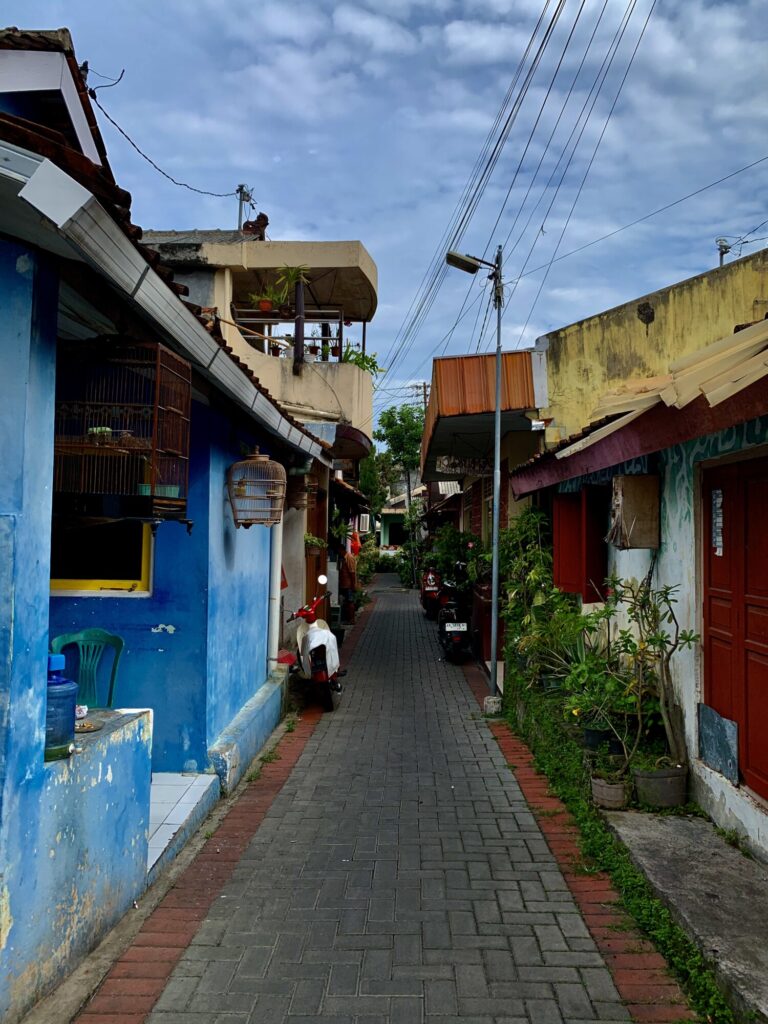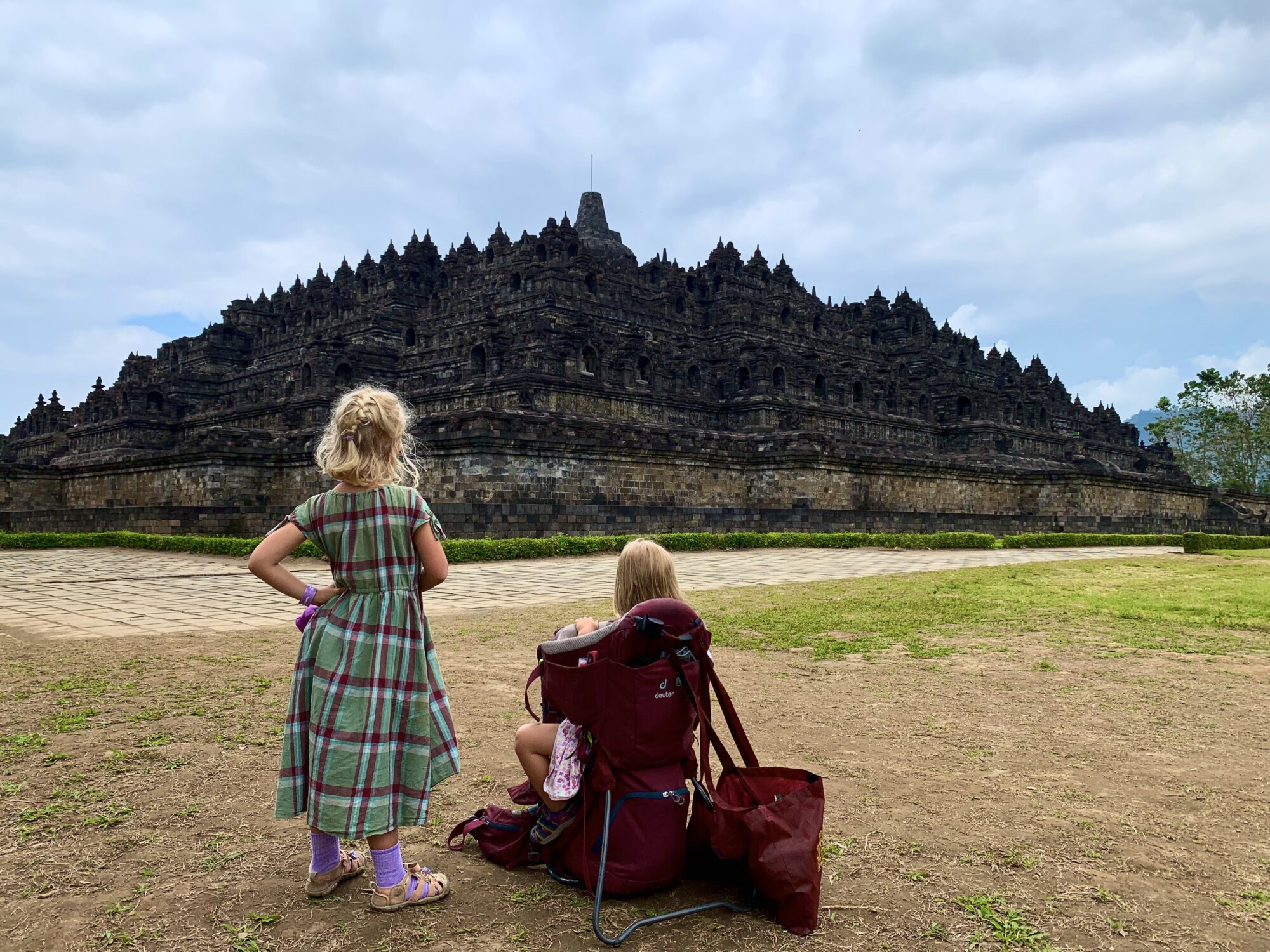We visited Taman Sari with kids because it kept coming up as a must-see in Yogyakarta. It’s one of those places locals visit too, which usually tells me it’s worth checking out. We weren’t sure how much the kids would care about a historic bathhouse, but we figured we’d let them wander and see what happened.
It ended up being a good mix of exploring, climbing, and imagining what life was like for royalty. The pools caught their attention right away, and even though you can’t swim, there’s something about the size and setup that makes it fun to walk through. If you’re heading to Indonesia and wondering whether this place is worth it with little kids, here’s exactly what we saw, how it went, and what I’d do differently next time.
Why Taman Sari with Kids? It’s a Local Favorite for a Reason
Taman Sari used to be a royal garden for the Sultan of Yogyakarta and included bathing pools, pavilions, and meditation areas. Today, only parts of the original complex remain, but the bathing area is still impressive and open to visitors. It’s a short walk or Grab ride from the Kraton and sits right in the middle of a local neighborhood, so it feels lived-in rather than fenced off.
We didn’t come with a tight plan. We just told the kids we were visiting a place where royals used to take baths. That was enough to spark their curiosity.
Here’s why it worked for us:
- It’s affordable and easy to access by Grab, bike, or on foot if you’re staying nearby.
- The main attraction, the bathing complex, is enclosed and manageable for young kids to explore.
- There are local vendors and shops right outside if you need a break or snack.
- It’s a great intro to Javanese history without needing a long tour or attention span.
If you’re planning your time in Yogyakarta, Indonesia and want something that doesn’t feel rushed or overwhelming with little ones, this is a good choice. It gave us space to explore, let the kids lead, and connect with a piece of history that’s still meaningful to the people who live there.
What Is Taman Sari and Why Should Families Visit?
Taman Sari was once part of a royal complex used by the Sultan of Yogyakarta. It was built in the mid-1700s as a space for rest, meditation, and bathing. Parts of it were also designed for defense, with hidden tunnels and escape routes. What’s left today is a section of that original layout, mostly the bathing pools, some lookout towers, and crumbling pathways that feel like something from a storybook.
Our kids loved the experience. They climbed stairs and peeked through windows. They ran through echoing tunnels and tried to figure out where they led. There’s no need for a deep history lesson, just the space to explore and a little imagination. If your family likes places that feel half playground, half time capsule, Taman Sari with kids is an easy win.
Getting to Taman Sari with Kids: Quick and Easy
We stayed just north of Ngasem Traditional Market, and Taman Sari was technically walkable from there. But with a recently sprained ankle in the mix, we booked a Grab and were there in just a few minutes. If you’re staying anywhere near Malioboro Street, Prawirotaman, or the Kraton, the ride will be short, cheap, and simple.
You’ll know you’ve arrived when you see the big open lot filled with scooters, some small vendor stalls, and locals milling about. There’s parking for motorbikes, and plenty of signage in both Indonesian and English. You won’t get lost trying to find the entrance.
Once you’re inside, it helps to know what to expect physically. This is not an easy place to navigate with a stroller.
Here’s why:
- There are stone steps leading into the bathing complex
- Some pathways are narrow, uneven, or crowded
- The doorways and archways are tight in spots
- The floors can be slick, especially after rain
If you’re bringing young kids, a child carrier is going to make your life so much easier. We used ours the entire time and were thankful we didn’t have to wrestle a stroller through crowds or around staircases.
Tips for arrival:
- Plan your visit for early morning to avoid the hottest part of the day
- Download the Grab app ahead of time if you haven’t already
- Bring cash for your tickets and any street snacks
- Expect to pay IDR 25,000 per adult and IDR 20,000 per child. There is a small extra fee if you bring a professional camera
It’s all very manageable, but going in with a little prep, especially if you have little ones, makes it feel a lot smoother.
What to Pack for Taman Sari with Kids
You don’t need a big daypack or special gear to visit Taman Sari. But a little planning goes a long way. It gets hot, there’s minimal shade, and once you’re inside the water palace complex, there are no shops or stalls. That means once you’re in, you’re in—so come prepared.
Here’s what we actually used and would pack again:
- Carrier instead of stroller
The walkways, stairs, and narrow passages make a stroller more of a burden than a help. We used a soft structured carrier, which made exploring easier and let our toddler nap while we wandered. - Sun protection
Bring hats, sunglasses, and sunscreen for everyone. There are a few shaded areas, but most of the site is open air with stone and concrete reflecting the heat. If you’re visiting mid-morning or early afternoon, it gets intense fast. - Water, snacks, and wipes
We packed plenty of water and some easy snacks like crackers and fruit. You’ll want wet wipes or sanitizer before and after snack breaks, especially since you’ll be touching handrails and climbing steps. Once you exit the main complex into the back alleyways, there are a few stalls selling snacks and iced drinks, but they’re not always open. - Light, respectful clothing
Breathable long pants and loose cotton shirts worked best for us. While there’s no strict dress code enforced, this is a cultural heritage site in a predominantly Muslim city. It’s always appreciated when visitors dress modestly, especially during call to prayer. - Comfortable shoes or sandals
You’re not hiking, but you’ll be walking on stone, tile, and uneven ground. We wore sandals and grippy sneakers, both worked fine. No need for hiking boots. - Cash (small bills)
Entry fees are paid in cash. At the time of our visit, adults were charged IDR 25,000. Having small change also helps if you want to tip a local guide or use a paid public bathroom nearby.
Optional but helpful:
- Portable fan if you’re visiting in the heat of the day
- Sarong for added sun protection or cultural respect if entering more sacred spaces
- Offline map downloaded ahead of time if you want to wander the alleyways beyond the pools
It’s not a long or strenuous visit, but the site layout and climate definitely call for packing smart. The less you carry, the more freely your kids can explore—and that’s the best part of visiting Taman Sari with kids.
Exploring the Water Palace: The Good, the Meh, and the Beautiful
The best part of visiting Taman Sari with kids is hands down the water palace pools. These are the main attraction and they’re easy to spot as soon as you enter. The pools sit below ground level, surrounded by tall cream-colored walls and old buildings that once housed royal family members and guests. You can’t swim in them, but they’re still striking enough to grab your kids’ attention immediately.
Our kids asked a hundred questions about how royalty used the space. They wandered across stone walkways, stared into the water, and ran from one courtyard to the next like they were on a scavenger hunt. Even without touching anything, it felt interactive enough to hold their interest.
Here’s what stood out:
- You enter through a small ticket gate, walk down a flight of stone stairs, and arrive in the main bathing area. There are two large pools and a central watchtower where the sultan supposedly viewed the women below.
- The site layout is mostly linear. You move in one direction, but what we didn’t know is that you can exit through the back gate and still re-enter through the front if you want more time inside.
- The call to prayer turned out to be a beautiful pause. Around 3 PM the complex began to clear out as many local visitors stepped away. We ended up with the pools almost entirely to ourselves.
- That quiet moment is when we found the hidden staircase. It leads to the top of the watchtower, giving you a full view of the pools below. The stairway is tucked behind a wooden door along the right-hand side. It’s easy to miss unless you see others going up or are looking for it.
This part of Taman Sari doesn’t take long, maybe 30 to 40 minutes, but it leaves an impression. It feels both grand and decayed, like you’re walking through something important that time forgot. And for kids, it’s just the right mix of mystery and movement to keep them engaged without overwhelming them.
If you have the chance, walk out the back gate and explore the alleyways. The palace complex was once much larger, and what’s left is scattered among family homes and side streets. It’s easy to miss, but if your kids still have energy, the wandering is part of the magic.
What’s the Connection Between Taman Sari and the Kraton?
The Kraton (sometimes spelled Keraton) is the official palace of the Sultan of Yogyakarta and is still in use today. That means parts of it are closed to the public, while others are more formal or museum-like. It’s considered the cultural and spiritual heart of the city.
Taman Sari, on the other hand, was once part of the greater Kraton complex. It was built in the mid-18th century as a private royal garden and bathing space. Back then, it also served as a defensive structure and retreat center, complete with underground tunnels, a mosque, and access to a larger system of manmade lakes and canals that no longer exist.
In simpler terms, if the Kraton was the sultan’s house, then Taman Sari was his private resort tucked inside the neighborhood.
We visited both, but not on the same day. And to be honest, if you are traveling with small children or on a limited timeline, we’d suggest starting with Taman Sari.
Here’s how they compare:
- Kraton
- Still a functioning royal residence
- Includes a museum with royal artifacts and traditional music displays
- Feels more formal and reserved
- Some areas are off-limits or restricted
- Requires more explanation to hold younger kids’ interest
- Taman Sari
- Feels more open and hands-on
- Has water features, towers, and tunnels kids can walk through
- Easier to explore at your own pace
- Feels like wandering through ruins with a story
The two sites are located only about a 10 to 15 minute walk apart, so you could combine them in one day, but we wouldn’t recommend it with tired kids. Each place deserves its own space to breathe. If you’re choosing one, go with Taman Sari with kids—it’s simpler, more visual, and far more engaging for little ones who like to move, touch, and explore.
How to Avoid the Crowds (And Get the Best Photos)
If you’re planning to visit Taman Sari with kids and you care about taking photos or just want a calmer experience, timing is everything. Most people will tell you to go first thing in the morning, and that’s solid advice. The light is soft, the air is cooler, and you’ll have fewer people in your shots.
But we did something different. We showed up around 3 PM, and that turned out to be a sweet spot. Just before call to prayer, a lot of local visitors begin to leave. The complex starts to quiet down, and the sunlight turns golden. It felt peaceful, like we had stepped into a version of the place that existed only for us.
We got some of our favorite photos during that time. Empty courtyards. No one walking through the background. And that stunning view from the upper level of the pool, which we would’ve missed if we rushed through.
A few tips for avoiding the crowds and catching good light:
- Weekdays are best. Avoid weekends and Indonesian holidays if possible.
- Early morning (right at opening time) is your best bet for quiet and cooler temps.
- Late afternoon (around 3 to 4 PM) is great for softer light and fewer people, especially leading up to Maghrib prayer.
- If it’s the rainy season, go early. Afternoon rains can hit suddenly and make the stone walkways slick.
- Most visitors are local families, which is wonderful to experience, but know that it gets busier after school hours and on Sundays.
There’s no wrong time to visit, but if you’re hoping for space to breathe or those postcard-style shots of your kids in front of the pools, planning your visit around these time windows can really make a difference.
The Underground Mosque and Other Hidden Gems
You’ll probably hear a lot about the underground mosque at Taman Sari. It’s one of those mysterious, Instagrammed places people look for when they visit Yogyakarta. And yes, it’s real—but here’s the current reality: the mosque has been closed since COVID and still hasn’t reopened due to ventilation and maintenance concerns. So while you can find the entrance and peek into where it used to be, you can’t go down there anymore.
Even though we couldn’t explore it, just seeing the old entryway and imagining what was once below was still worth the walk.
That said, don’t skip the rest of the grounds beyond the main pools. What surprised us the most was how much we enjoyed wandering the area around Taman Sari after we thought we were done.
Here’s what to look for beyond the water palace:
- Tunnels you can still walk through, though none lead directly to the closed mosque
- Back alleyways full of colorful murals, old archways, and crumbling stone walls
- Local homes built right into the original palace ruins, where modern life and history blend
- A few hidden staircases and towers with great views over the rooftops
- Small souvenir stalls and snack vendors tucked into quiet corners
It feels less like a single tourist site and more like a small village layered on top of forgotten history. We didn’t take a guide, but someone kind of informally showed us around for a small tip, and honestly, we were grateful. The back paths can get confusing, and signs are limited.
So if you’ve got a little extra energy after the pools, this is where the real exploration starts. It’s not polished or mapped out like a museum, it’s just you and your kids discovering what’s left of the royal water palace as it quietly blends into everyday life in Indonesia.
Snacks, Bathrooms, and Kid Breaks
There’s no playground at Taman Sari, so don’t expect slides or swings. But that doesn’t mean you can’t find a spot to pause, refuel, and let your kids catch their breath. After walking through the main complex, we exited out the back and found a quiet stretch of curb to sit and regroup. We pulled out snacks, passed around water, and just watched the neighborhood go by. It was low-key and honestly one of the best parts of the afternoon.
Here’s what to expect when it comes to breaks with kids:
- Local vendors are scattered around the entrance and in the alleyways behind the complex. You’ll find bottled water, packaged snacks, simple hot food, and sweet iced coffee. It’s basic but does the job. Bring cash.
- Bathrooms are not inside the water palace itself, but you’ll find small toilet stalls nearby. Some are run by locals and charge a small fee. They are usually squat toilets with buckets, so manage expectations and bring your own toilet paper or tissues.
- Bring your own wipes and hand sanitizer. Between stone staircases, railings, and snack breaks, your hands will need a reset more than once.
- No designated rest areas or seating. We used ledges, low walls, or a step outside a closed shop to sit for a few minutes. If you need shade, a few alleyways offer cover between buildings, but it is mostly open air.
If your kids are the kind who need a full stop mid-visit, plan to take that break just after you exit the bathing pools. That’s when everyone’s legs get tired and it helps to sit, snack, and reset before exploring the back area or heading home. Keep it simple. Some crackers, cold water, and ten minutes on the curb go a long way.
Should You Visit Taman Sari with Kids? Absolutely.
If another mom asked me whether Taman Sari is worth visiting with kids, I’d say yes, definitely go. Just know what you’re walking into. This isn’t a theme park or a museum with flashy exhibits. There’s no guide with a microphone explaining every detail. What you get instead is something quieter and, in some ways, better.
Taman Sari is layered. It’s beautiful and a little broken. It sparks imagination. It invites kids to wander and explore without needing to understand every historical fact. Our kids loved the idea that royalty used to live and bathe here. They were into the echo of the tunnels and the stillness of the pools. They didn’t need to touch or play with anything. Just walking around was enough to light up their curiosity.
Here’s why it’s worth adding to your itinerary:
- The site is compact enough for short attention spans but full of surprises for curious kids
- The water palace area is visually interesting even for young children
- You can explore at your own pace without crowds if you time it right
- It gives kids a chance to move, imagine, and feel a piece of history without being told how to experience it
Let them wander. Let them ask questions. Let them climb a few stairs and peek through a window that once framed palace life. They might not remember the name of the Sultan, but they’ll remember the feeling of discovering something old and grand all on their own.
For us, Taman Sari with kids wasn’t about checking off a bucket list stop in Yogyakarta. It was about giving our kids the space to explore something unfamiliar, and letting that be enough.
One Thing the Guidebooks Don’t Tell You…
Yogyakarta is not trying to be Bali, and honestly, that’s part of the reason it’s so special. This city has its own pulse. It’s full of scooters, street vendors, layers of history, and a deep connection to Javanese culture and Islam. It can be loud and crowded, but also sacred and still. That contrast is part of the experience.
When we visit places like Taman Sari with kids, we try to remember we’re not just tourists—we’re guests. That means adjusting how we show up. It means long, breathable pants even in the heat. It means being quiet during the call to prayer, not just out of respect but because those moments are powerful to witness.
A few things we kept in mind:
- Most of Indonesia is Muslim, especially on Java. Modest dress is appreciated in places like Taman Sari and the nearby Kraton.
- The call to prayer happens five times a day, and during that time, many visitors pause or leave, especially in the late afternoon.
- Public affection, loud behavior, and flashy clothing feel out of place in these spaces. Our kids picked up on that too and naturally quieted down.
No one’s standing there with a rule book. But the more you slow down and observe, the more you start to feel the rhythm of daily life in Yogyakarta. You realize that exploring isn’t just about seeing things. It’s about noticing the way people live, honoring that, and choosing to move through it with humility and presence.
Taman Sari isn’t just a place to take photos. It’s a chance to fold your family into the story of a place that existed long before you, and will still be standing long after. That kind of travel doesn’t come from rushing through it. It comes from walking quietly, noticing more, and letting the experience settle in.


